/ Home / Attractions / Plaça del Duc de MedinaceliPrint version
Plaça del Duc de Medinaceli
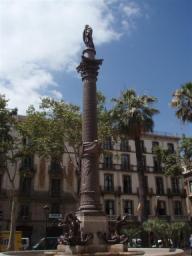 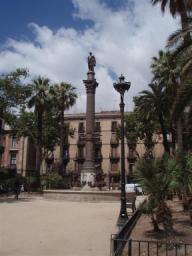 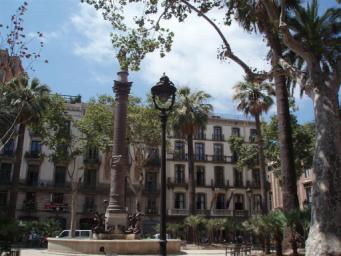 .JPG.medium.jpg)
|

|
Historic information
The Plaça del Duc de Medinaceli was built in 1844, in the shadow of the sea wall, on the site of the former convent of Sant Francesc. The square was designed by Francisco Daniel Molina, who was a municipal architect in Barcelona until 1858 and also planned the Plaça Reial (1858). In the middle of the square stands a monument dedicated to Admiral Galcerán Marquet, which is made of wrought iron, the first time this material was used in the city to make decorative elements on the public thoroughfare. This monument, which has a fountain at its base, is a fine example of architectural design and superb sculpture, and surrounded by 19th-century palm trees. This intervention was carried out within the framework of a widespread process in the city to replace convents with public spaces.
The convent of Sant Francesc was built in the 13th century as a tribute to Saint Francis’s visit to the city and was inaugurated by King Jaume I. The monastery complex stretched from the square as far as La Rambla. The fact that all the monarchs of Aragon (from the 14th to the 16th centuries) swore the constitutions and charters here on their arrival in Barcelona, is proof of the importance of the site. This noteworthy building, which had a large cloister built in the 16th century, was demolished after 1882. Following the demolition of the convent, the Duke of Medinaceli claimed ownership of the site, as the heir of the Catalan noble families who had transferred it to build on, and, with the aim of ingratiating himself with the city, gave over some of the land to build the square.
The convent of Sant Francesc was built in the 13th century as a tribute to Saint Francis’s visit to the city and was inaugurated by King Jaume I. The monastery complex stretched from the square as far as La Rambla. The fact that all the monarchs of Aragon (from the 14th to the 16th centuries) swore the constitutions and charters here on their arrival in Barcelona, is proof of the importance of the site. This noteworthy building, which had a large cloister built in the 16th century, was demolished after 1882. Following the demolition of the convent, the Duke of Medinaceli claimed ownership of the site, as the heir of the Catalan noble families who had transferred it to build on, and, with the aim of ingratiating himself with the city, gave over some of the land to build the square.
In order to know the zone better
Among the manor houses that still can be found in the square the most outstanding is the one located at number 8 on the corner with Carrer Anselm Clavé (it is a hotel currently). The first owner was Antonio López i López, one of the most influential businessmen in the second half of the 19th century. It has a balcony with marble balustrades which was a characteristic feature of Barcelona’s civil architecture in the 19th century. In the house located at number 3 on the corner with Carrer Ample was born Josep Anselm Clavé, a 19th century musician who created Cors de Clavé, an institution with socio-artistic purposes made up of singing workers. It used to be the Counts of Santa Coloma’s palace, and later it belonged to Manel Girona, a banker who was also Barcelona’s mayor. The house nowadays hosts Barcelona’s Civil Registry.
From the 18th century onwards, the Carrer Ample became Barcelona’s social and commercial hub. The viceroys of Catalonia, the aristocracy, the upper middle classes, the traders associated with the seafaring world, prestigious shipowners, etc., hurried to build their houses in this street. Nowadays, in contrast to the restaurants and ethnic shops, you can still see buildings dating back over 200 years which have been converted for other purposes. An important building at number 31, Carrer Anselm Clavé, the extension of the Carrer Ample to the Portal de la Pau, is the Palau del Marquès de Alfarrás, now the headquarters of the Ombudsman. The building was constructed in 1744 by the architects Joan Anton Desvalls and the Italian Domenico Bagutti, who also designed the Horta maze, which was also owned by the Marquès de Alfarrás. The registry office building separates the Plaça del Duc de Medinaceli and the Plaça de la Mercè, one of the most attractive spots in the area. The church of La Mercè was designed by Josep Mas and built between 1765 to 1775, according to the canons of the Counter-Reformation. It has a Latin-cross ground plan with a tower and dome over the crossing. The façade is of particular interest as it is the only example of Barcelona baroque to combine a flat frontage and concave walls. A shrine was added by Joan Martorell in 1888 where people come to worship the Gothic image of the city’s co-patron saint Our Lady of Mercy, by Pere Moragues. The shrine is also of considerable importance as this type of structure is not commonly found in a city church.
The square stands close to the La Rambla, the medieval shipyards, the Drassanes, and the old harbour, the Port Vell.
From the 18th century onwards, the Carrer Ample became Barcelona’s social and commercial hub. The viceroys of Catalonia, the aristocracy, the upper middle classes, the traders associated with the seafaring world, prestigious shipowners, etc., hurried to build their houses in this street. Nowadays, in contrast to the restaurants and ethnic shops, you can still see buildings dating back over 200 years which have been converted for other purposes. An important building at number 31, Carrer Anselm Clavé, the extension of the Carrer Ample to the Portal de la Pau, is the Palau del Marquès de Alfarrás, now the headquarters of the Ombudsman. The building was constructed in 1744 by the architects Joan Anton Desvalls and the Italian Domenico Bagutti, who also designed the Horta maze, which was also owned by the Marquès de Alfarrás. The registry office building separates the Plaça del Duc de Medinaceli and the Plaça de la Mercè, one of the most attractive spots in the area. The church of La Mercè was designed by Josep Mas and built between 1765 to 1775, according to the canons of the Counter-Reformation. It has a Latin-cross ground plan with a tower and dome over the crossing. The façade is of particular interest as it is the only example of Barcelona baroque to combine a flat frontage and concave walls. A shrine was added by Joan Martorell in 1888 where people come to worship the Gothic image of the city’s co-patron saint Our Lady of Mercy, by Pere Moragues. The shrine is also of considerable importance as this type of structure is not commonly found in a city church.
The square stands close to the La Rambla, the medieval shipyards, the Drassanes, and the old harbour, the Port Vell.
|
Scene description
All about my mother
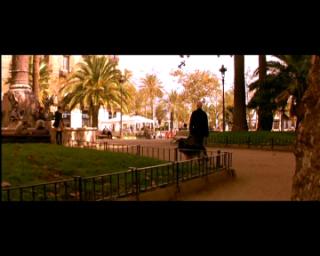 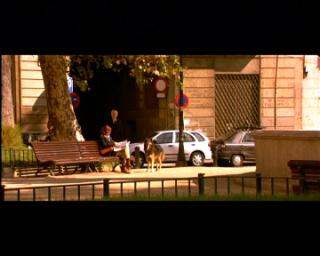 .JPG.medium.jpg)
Plaça del Duc de Medinaceli: 1.Panning shot of the square. The palms, plane trees, fountain and cement benches provide a feeling of tranquillity. Manuela (Cecilia Roth) and Rosa (Penélope Cruz) arrive in the square by taxi. Rosa sees her father (Fernando Fernán Gómez) and his dog Sapic from the car. When they leave, the scene ends with a new shot of the square.
2.New panning shot of the square with a circular tracking shot that ends at the door of a bar, located in the same square. A number of shots of the square from inside the bar. Manuela (Cecilia Roth) and Lola (Toni Cantó) meet inside the bar. Final shot of the square from inside the bar, showing Rosa’s mother (Rosa Maria Sardà) at the door. |
Did you know that...
In the film, the square is supposed to be very near Rosa’s parents’ house, whereas in reality the Casas Ramos, in the Plaça Lesseps, and the Plaça del Duc de Medinaceli are about 5 kilometres apart.
The producer and director’s brother Agustín Almodóvar has a cameo in the film. He plays the taxi driver who takes Manuela and Rosa to the square. The taxi is also travelling in the opposite direction to the traffic in the square. |
The Barcelona of Pedro Almodovar
/
Plaça del Duc de Medinaceli

